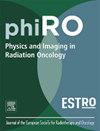Feasibility of prompt gamma verification for cone-beam computed tomography-based online adaptive proton therapy
IF 3.4
Q2 ONCOLOGY
引用次数: 0
Abstract
Background and purpose
Prompt-gamma based in vivo treatment verification, such as prompt-gamma imaging (PGI), is crucial for detecting anatomical changes and serving as safety net during proton therapy treatments. This is especially important in an online-adaptive setting, when imaging will be based on cone-beam computed tomography (CBCT). This study investigated whether PGI, proven effective to detect relevant anatomical changes in clinical settings, can also verify treatment plans adapted on CBCTs, particularly the reliability of CBCT-based PGI-simulations of expected prompt-gamma distributions, a key requirement for PGI-based verification.
Material and methods
For a homogeneous and anthropomorphic phantom, a fan-beam computed tomography (CT) and a CBCT were acquired. Corrected CBCT and virtual CT datasets were generated. PGI simulations and independent dose calculations were performed on the different CBCT datasets and compared to the fan-beam CT, extracting PGI-based and integrated-depth-dose (IDD)-based range-shifts. For three head-and-neck cancer patients, PGI-based shifts between the fan-beam CT and a synthetic CT (from a daily CBCT) were compared to line-dose-based shifts from clinical dose calculations.
Results
For the homogeneous phantom, all CBCT datasets enabled adequate PGI simulations, with PGI-based shifts correlating very closely with IDD-based shifts. For the anthropomorphic phantom and the three patient datasets, observed PGI-based shifts were correlated to IDD-based shifts.
Conclusions
For phantom and patient data, PGI simulations depended mainly on the reliability of depth-dose distributions on the planning image with negligible uncertainties from PG emission. For CBCT-based OAPT, correct depth-dose distributions are required. Hence, PGI is also a promising treatment verification tool for CBCT-based OAPT.
基于锥形束计算机断层成像的在线自适应质子治疗的即时伽玛验证的可行性
背景和目的基于提示伽马的体内治疗验证,如提示伽马成像(PGI),对于检测解剖变化和在质子治疗过程中作为安全网至关重要。当成像将基于锥束计算机断层扫描(CBCT)时,这在在线适应环境中尤为重要。本研究调查了PGI在临床环境中检测相关解剖变化的有效性,是否也可以验证适用于cbct的治疗方案,特别是基于cbct的PGI模拟预期即时伽马分布的可靠性,这是基于PGI验证的关键要求。材料和方法采用扇束计算机断层扫描(CT)和CBCT对均匀的拟人化幻影进行观察。生成校正后的CBCT和虚拟CT数据集。在不同的CBCT数据集上进行PGI模拟和独立剂量计算,并与扇束CT进行比较,提取基于PGI和基于综合深度剂量(IDD)的距离位移。对于三名头颈癌患者,将扇束CT和合成CT(来自每日CBCT)之间基于pgi的偏移与临床剂量计算的基于线剂量的偏移进行比较。对于均匀幻像,所有CBCT数据集都能够进行充分的PGI模拟,基于PGI的偏移与基于idd的偏移非常密切相关。对于拟人化幻像和三个患者数据集,观察到的基于pgi的移位与基于idd的移位相关。结论对于幻影和患者数据,PGI模拟主要依赖于规划图像的深度剂量分布的可靠性,PG辐射的不确定性可以忽略不计。对于基于cbct的OAPT,需要正确的深度剂量分布。因此,PGI也是一种很有前景的基于cbct的OAPT治疗验证工具。
本文章由计算机程序翻译,如有差异,请以英文原文为准。
求助全文
约1分钟内获得全文
求助全文
来源期刊

Physics and Imaging in Radiation Oncology
Physics and Astronomy-Radiation
CiteScore
5.30
自引率
18.90%
发文量
93
审稿时长
6 weeks
 求助内容:
求助内容: 应助结果提醒方式:
应助结果提醒方式:


